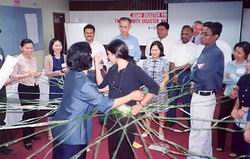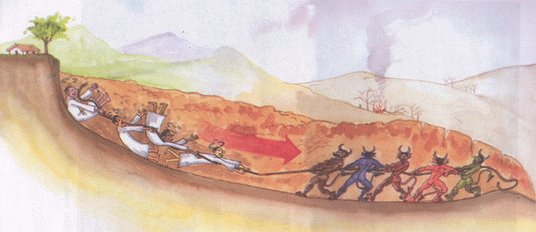 |
Vol. 8, No. 4 October-December 2002
|
Pedagogy for Safer Cities
Answers to such questions are important for governments, donors and other development and disaster risk management-related organizations. If scarce resources are allocated to human resources development through international training, is that an appropriate strategy? Or should the money be spent on other interventions? It is also essential for individual professionals to understand the potential benefits, before they take a decision to participate in international training. To answer these questions, a tracer survey was conducted by ADPC with 100 alumni of the Urban Disaster Mitigation and Urban Flood Mitigation Courses. The respondents were from Bangladesh, Cambodia, India, Lao PDR, Nepal, the Philippines, Sri Lanka and Thailand. The survey findings indicated that international training impact on urban disaster mitigation was multi-dimensional, multi-sectoral and multi-layered, as the following examples illustrate. Implementation of Projects Project design and implementation was an important area of intervention affected by alumni’s newly-gained skills and knowledge. They were able to apply these in implementing their organizations’ ongoing programs more efficiently. “In the application designs as done for projects by the corporation, sensitivity to flood mitigation is heightened albeit not asked for as a design criteria – but still one does not know when nature strikes, and it is always good to know that one has done a job with sensitivity to the lives of humans and animals in an otherwise chaotic development process.” Mr S Raj Surin, Senior Project Appraisal Officer, Housing and Urban Development Corporation (HUDCO), India Risk-sensitive Town Planning Alumni find themselves motivated and skilled in preparing disaster risk-sensitive town and development plans, contrary to past trends where disaster risk was not included. “As a town planner, the zoning plans which I am involved in are fully studied from a disaster vulnerability perspective and as a mitigation measure, vulnerable areas (such as forests) are designated as non-public use zones.” Mr K A D Chandradasa, Deputy Director, Sri Lankan Urban Development Authority Training Many professionals realized that the new concepts and skills they learned in international training were vital for their colleagues and country fellows. Some developed and conducted local-level courses on urban disaster mitigation. “I organized and facilitated about 40 training sessions in my working area using the training techniques and methods of the course.” Mr John Dibakar Roy, World Vision Bangladesh Education Universities in South and Southeast Asia are acknowledging the importance of teaching the concepts of disaster risk management to future urban planners, city officials, architects, geologists and other professionals. “We have incorporated disaster mitigation as a module in our environmental management course both in the masters program and in short-term offerings.” Ms Maria Concepcien Pabalan, Director, Local Development and Environment Management, Development Academy of the Philippines Public Awareness Others identified disaster risk communication as the locus of their efforts, since they believed that aware communities would be better able to undertake actions for their safety, be it direct or through advocacy with the government. “Educating people living along the Mekong River and around the Tonle Sap basin created awareness on preparedness actions, to protect their lives and properties.” Lt Col Mey Virakk, National Committee for Disaster Management (NCDM), Cambodia Guidelines on Safer Construction The staff of Sri Lanka’s National Building Research Organization (NBRO), and World Vision Bangladesh, developed “Guidelines for Construction and Human Settlements in Flood Prone Areas” and “Guidelines on Flood Damage Assessment and Needs Analysis”. While this was being done in Bangladesh and Sri Lanka, architects in other countries took it upon themselves to ensure the incorporation of seismic-resistant features in building design. Community Based Disaster Mitigation John Dibakor Roy from Bangladesh found it essential to organize community groups for flood mitigation planning and implementation: “I formed 11 community and volunteer groups at Union level, who will work before, during and post-disaster. They will manage everything independently and use their local resources. They have local level action plans. Community volunteers prepared their Risk and Resource Mapping and display it to their community for their awareness.” Preparedness Planning Mr Girish Chandra Murmu, Commissioner of Relief and Secretary, Revenue Department, Government of Gujarat, said, “As Commissioner of Relief, my duties are related to rescue, relief and rehabilitation of people affected by all natural or manmade calamities. Learning from the course helped me in preparedness planning and relief operations. The course helped me in carrying out flood preparedness exercises during the monsoon.” Research Professor Chira Prangkio from the University of Chiang Mai Department of Geography, Thailand, initiated research work on “Flood and Land-slide Hazard Zonation in Phayao Province”. He also advises students on their flood mitigation-related research. Job Performance A number of professionals found the course helpful in improving their work efficiency in different ways. Engineer Ojha from Nepal reported that, “I have got additional responsibilities in flood mitigation in the urban sector. It helped me a lot to upgrade my knowledge and I am now Chief of Environmental and Flood Drainage Section.” Conclusion It can be concluded from the alumni responses that the impact of international training was varied, due to factors related to country context, organizational mandate and job description of the professionals who attended the training. Participants were able to draw on the knowledge and skills taught in the course to design multi-dimensional activities and projects within the mandate and jurisdiction of their organizations. Training was instrumental in the transfer of such knowledge and skills as land-use planning for urban settlements. The survey showed that the training was equally influential in its impact on the public and private sectors. Training in urban disaster mitigation is conducted by ADPC at Bangkok. The courses include Urban Disaster Mitigation (UDM), Technological Risk Mitigation in Cities (TRMC), Flood Risk Management (FRM), Earthquake Vulnerability Reduction in Cities (EVRC) and Disaster Risk Communication (DRC). Zubair Murshed is working as a Training Manager at ADPC. He can be contacted at mzubair@ait.ac.th Twenty-ninth Disaster Management Course in Bangkok
The 29th Disaster Management Course was held from 4-22 November 2002 in Bangkok, Thailand, with 29 participants from Bangladesh, China, India, Indonesia, Malaysia, the Philippines, Singapore and Thailand. The three-week intensive course was conducted in an interactive manner, with equal emphasis given to classroom lectures on theory and practice-simulation exercises, to facilitate optimum learning and sharing of experiences among participants from the eight countries. The course highlight was the “Exercise Enterprise”, a simulation of a crisis control center which lasted a whole day and concluded in an interview with the Prime Minister of Attitlan (a mythical country). Other exercises included a team-building and management exercise called “Aqua” that was held in the AIT Conference Center swimming pool. Field trips included a visit to the Geo-Informatics and Space Technology Development Agency, a Gistda satellite mapping facility in Thailand. Linda Edwards, from Swinburne TAFE in Australia, and Joe Barr gave interesting presentations on “crisis and damage and needs analysis”. The lessons learned will help in improvements for the next Disaster Management Course in 2003.
|
|||||||||||||||||||||||||||||||||


